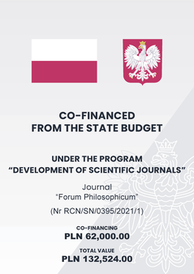- Home »
- Issues »
- 28/2 – Fall 2023 »
- Articles »
The Phenomenological Counter-intentionality of the Icon
Jean-Luc Marion’s Reception of Nicholas of Cusa’s Eicona Dei
Abstract
The main goal of this paper is to show Nicholas de Cusa’s influence on the notion of Icon (icône) as counter-intentionality in Jean-Luc Marion’s phenomenology of givenness. In order to do this, first, we offer a study of the early conception of Icon in Marion, as it appears in L’Idole et la distance (1977) and Dieu sans l’être (1982), showing the passage from an early conception of the icon to its first phenomenological formulation. As we will see, in this early period there is already an influence of the christian neoplatonic tradition (Dionysius the Areopagite). Secondly, we analyze the reception practiced by Marion of the Nicholas of Cusa’s thought. In this case, we indicate specifically how the Cusanian notion of eicona dei appears as a fundamental historical antecedent of the Icon as a saturated phenomenon, thus revealing the importance of Christian Neoplatonism in the phenomenology of givenness.
Keywords
Cite this article
Pizzi, Matías. 2023. “The Phenomenological Counter-intentionality of the Icon: Jean-Luc Marion’s Reception of Nicholas of Cusa’s Eicona Dei.” Forum Philosophicum 28 (2): 261–73. doi:10.35765/forphil.2023.2802.16.
Bibliography
Beierwaltes, Werner. 1978. Visio absoluta. Reflexion als Grundzug des göttlichen Prinzips bei Nicolaus Cusanus. Heidelberg: Carl Winter. D’Amico, Claudia. 2011. “Die Produktivität der visio absoluta bei Cusanus: die Vorgänger im mittelalterischen Neoplatonismus.” In Videre et videri coincident: Theorien des Sehens in der ersten Hälfte des 15. Jahrhunderts, edited by Harald Schwaetzer, Christian Schneider, Iñigo Bocken, 17–32. Münster: Aschendorf Verlag. Ludueña, Ezequiel. 2005. “Teología mística y cristología. El Pseudo Dionisio y Nicolás de Cusa.” In El problema del conocimiento en Nicolás de Cusa: Genealogía y proyección, edited by Jorge Machetta, Claudia D’Amico, 109–115. Buenos Aires: Biblos. Marion, Jean-Luc. 1971. “Distance et Louange. Du concept de Réquisit (aitia) aus status trinitaire du langage theologique selon Denys le Mystique.” Résurrection. Revue de doctrine crhétienne 38: 89–118. —. 1982. Dieu sans l’être. Paris: Fayard. —. 2001a. De surcroît: études sur les phénomènes saturés. Paris: PUF. —. 2001b. The Idol and Distance. New York: Fordham University Press. —. 2003. Le phénomène érotique. Paris: Grasset. —. 2008. Au lieu de soi. L’approche de Saint Augustin. Paris: PUF. —. 2010. Certitudes negatives. Paris: Grasset. —. 2012a. God Without Being. Chicago: University of Chicago Press. —. 2012b. La rigueur des choses. Paris: Flammarion. —. 2013a. Étant donné. Essai d’une phénoménolgie de la donation. Paris: PUF. —. 2013b. L’Idole et la distance. Paris: Grasset & Fasquelle. —. 2016. “Seeing, or Seeing Oneself Seen: Nicholas of Cusa’s Contribution in De visione dei.” Journal of Religion 96: 305–331. —. 2020. D’ailleurs, la revelation. Paris: Grasset. Pizzi, Matías. 2019. “La controversia Falque-Marion sobre el eicona dei cusano: ¿una insospechada concordantia philosophorum?” Escritos de Filosofía 6: 106–124. —. 2020a. “Alcanzar a Dios sin Dios. La relación entre fenomenología y teología en Edmund Husserl y Jean-Luc Marion.” Areté. Revista de Filosofía. 32 (2): 417–441. https://doi.org/10.18800/arete.202002.006. —. 2020b. “Exploraciones sobre el lenguaje no-predicativo en la fenomenología de Jean-Luc Marion: Dionisio Areopagita y Friedrich Nietzsche.” Revista Litura 2: 1–13. Roggero, Jorge. 2016. “La función del arte en la fenomenología de la donación de J.-L. Marion.” Investigaciones fenomenológicas 13: 173–192. https://doi.org/10.5944/rif.13.2016.29620.





